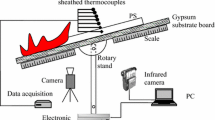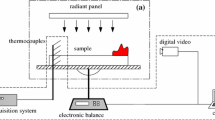Abstract
Expanded polystyrene (XPS) is an important building exterior wall insulation material at present, and the investigation of fire behavior characteristics is an important way to solve the fire safety problem of XPS. In this study, the influence of low oxygen conditions and external radiation source on smoke and heat release characteristics of XPS are compared and investigated, and the fire spread characteristics of XPS under low oxygen conditions are also studied by investigating the characteristic parameters such as flame height, width, flame spread index and spread rate. The results indicate that the pyrolysis combustion of XPS is inhibited with the decreased oxygen concentration in the environment, resulting in reduced the ignition time and increased Smoke Produce Rate (SPR) peak. Moreover, the low oxygen condition has little effect on the heat release peak and total heat release of normal ignited materials due to the stable heat radiation source, but the heat release peak and total heat release is reduced greatly in the fire spread experiment. At the same time, there is a positive correlation between the heat release rate and the flame propagation index (FPI) under low oxygen conditions. This paper provides important data and theoretical support for the design and fire theory research of XPS.









Similar content being viewed by others
References
Engels HW, Pirkl HG, Albers R, Albach RW, Krause J, Hoffmann A, Casselmann H, Dormish J. Polyurethanes: versatile materials and sustainable problem solvers for today’s challenges. Angew Chem Int Ed Engl. 2013;52:9422–41.
Chen JG. Pyrolysis and combustion characteristics of PS thermal insulation materials at two altitudes. Anhui University of Technology, 2018.
Mehta S. Thermal degradation of foamed polystyrene. J Mater Sci. 1995;30:2944–9.
Linteris GT, Lyon RE, Stoliarov SI. Prediction of the gasification rate of thermoplastic polymers in fire-like environments. Fire Safety J Int J Devoted Res Fire Safety Sci Eng 2013;60.
Pravin K, et al. A review of physical and kinetic models of thermal degradation of expanded polystyrene foam and their application to the lost foam casting process. J Anal Appl Pyrol. 2007;78:162–71.
Pravin K, et al. Kinetics of thermal decomposition of expandable polystyrene in different gaseous environments. J Anal Appl Pyrol. 2009;84:139–44.
Wang Y, Kang WD, Chen C, et al. Combustion behaviour and dominant shrinkage mechanism of flexible polyurethane foam in the cone calorimeter test. J Hazard Mater. 2019;365:395–404.
Jiao LL, et al. Kinetics and volatile products of thermal degradation of building insulation Materials. Thermochim Acta. 2012;547:120–5.
Jeffery D, et al. Kinetics of the thermal and thermo-oxidative degradation of Polystyrene, Polyethylene and Poly(propylene). Macrolamocular Chem Phys. 2001;202:775–84.
Attia NF. Organic nanoparticles as promising flame retardant materials for thermoplastic polymers. J Therm Anal Calorim. 2017;127:2273–82.
Attia1 NF, Saleh BK, Novel synthesis of renewable and green flame-retardant, antibacterial and reinforcement material for styrene–butadiene rubber nanocomposites, J Therm Anal Calorim 2020;139:1817–1827
Attia1 NF, Sustainable and efficient flame retardant materials for achieving high fire safety for polystyrene composites. J Therm Anal Calorimetry, 2022,147:5733–5742
Attia FN, Elashery SEA, Zakria AM. Recent advances in graphene sheets as new generation of flame retardant materials. Mater Sci Eng, B. 2021;274: 115460.
Kannan P, et al. Kinetics of thermal decomposition of expandable polystyrene in different gaseous environments. J Anal Appl Pyrol. 2009;84:139–44.
Quintiere JG. The effects of angular orientation on flame spread over thin materials. Fire Saf J. 2001;36:291–312.
Quintiere JG. simplified theory for generalizing results from a radiant panel rate of flame spread apparatus. Fire Mater. 1981;5:52–60.
Xu Q, Majlingova A, Zachar M, et al. Correlation analysis of cone calorime test data assessment of the procedure with tests of different polymers. J Thermal Anal Calorimetry 2012; 110: 65–70.
Khan MM, Tewarson A, Chaos M. Combustion characterisitcs of materials and generation of fire products. The SFPE Handbook of Fire Protection Engineering. 2016;5:1143–232.
DeRis JND, Spread of a laminar diffusion flame. Symposium (International) on Combustion 1969; 12: 241–252.
Williams EA, Mechanisms of fire spread. Symposium (International) on Combustion1997;16:1281–1294.
Williams EA, Combustion Theory.198, Menlo Park: Benjamin Cummings.
An WG, Yin XW, Cai ML, et al. Influence of vertical channel on downward flame spread over extruded polystyrene foam. Int J Therm Sci. 2019;145: 105991.
An WG, Jiang L, Sun JH, et al. Correlation analysis of sample thickness, heat flux, and cone calorimetry test data of polystyrene foam. J Therm Anal Calorim. 2015;119:229–38.
An WG, Xiao HH, Liew KM, et al. Downward flame spread over extruded polystyrene: effects of sample thickness, pressure and sidewalls. J Therm Anal Calorim. 2015;119:1091–103.
Zhang Y, et al. Experimental study on the characteristics of horizontal flame spread over XPS surface on plateau. J Hazard Mater. 2011;189:34–9.
Tu R, Ma X, Zeng Y, Zhou XJ, Zhang QX, Wang JW, Fang J. Influences of sub-atmospheric pressure on downward flame spread over typical insulation material with parallel glass curtain wall structure in underground buildings. Tunn Undergr Space Technol. 2020;103: 103509.
Xu L, et al. Melting flow burning fire performance of thermoplastic materials. J Combust Sci Technol. 2010;2:187–91.
Feng HP. Quantitative calculation method of three-dimensional apparent porosity of soil based on scanning electron microscope images. J Geotech Eng. 2019;3:574–9.
Jiang MJ, Li T, et al. DEM analyses of one-dimensional compression and collapse behaviour of unsaturated structural loess. Comput Geotech. 2014;60:47–60.
Acknowledgements
National Natural Science Foundation of China (Grant No. 52074247, 52274232); National Key Research and Development Program (Grant No. 2020JBKY02); Fundamental Research Funds for China Academy of Safety Science and Technology (Grant No.2020JBKY02).
Author information
Authors and Affiliations
Corresponding author
Additional information
Publisher's Note
Springer Nature remains neutral with regard to jurisdictional claims in published maps and institutional affiliations.
Rights and permissions
Springer Nature or its licensor (e.g. a society or other partner) holds exclusive rights to this article under a publishing agreement with the author(s) or other rightsholder(s); author self-archiving of the accepted manuscript version of this article is solely governed by the terms of such publishing agreement and applicable law.
About this article
Cite this article
Qian, X., Li, S., Shi, C. et al. The study of smoke, heat release and fire spread characteristics of expanded polystyrene under low oxygen condition. J Therm Anal Calorim 148, 821–829 (2023). https://doi.org/10.1007/s10973-022-11788-5
Received:
Accepted:
Published:
Issue Date:
DOI: https://doi.org/10.1007/s10973-022-11788-5




